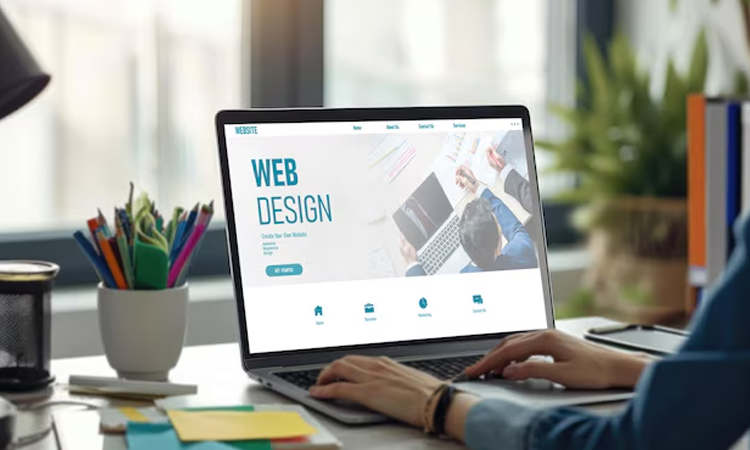
10 Essential Tips for Choosing the Perfect Website Design for Your Business

In today’s digital world, your business website is often the first impression customers have of you. Whether you’re starting a new website or redesigning an old one, choosing the right design is key. A well-designed website helps you attract visitors, keep them interested, and make it easy for them to take action—like buying something or contacting you.
In this blog, we’ll share 10 simple tips to help you choose the perfect website design for your business. These tips will help you create a site that looks good, works well on all devices, and keeps your customers happy.
1. Understand Your Brand’s Identity
Before you start designing your website, think about what your business represents. Your website should match your brand’s personality. For example, if your brand is fun and playful, your website can use bright colors and a casual style. If your brand is more serious and professional, a clean, simple design with neutral colors might be a better fit.
Knowing your brand will help you make design choices that send the right message to your visitors.
Tip: Write down the key values or feelings you want your website to show. This will guide your design decisions.
2. Make Sure It Works on Mobile Devices
If your website doesn’t look good or work well on a phone or tablet, you could be losing customers.
A mobile-friendly website design adjusts to different screen sizes, ensuring that it looks great on any device. When building your site, make sure it’s responsive. This means the layout will automatically change to fit smaller screens without looking crowded or broken.
Tip: Test your website on different mobile devices before launching. This helps you spot any problems early.
3. Keep User Experience (UX) in Mind
User Experience (UX) is all about making your website easy and enjoyable for visitors to use. A website with good UX lets people find what they need quickly and without frustration. It means having simple menus, easy-to-read text, and a smooth, clear path from one page to the next.
Tip: Imagine you are a visitor on your site. How easy is it to find your products or services? If it’s hard to navigate, make changes to improve the experience.
4. Choose the Right Color Scheme
Colors play a big role in how people feel about your business. Different colors can create different emotions. For example, blue often makes people feel calm and trusted, while red can create excitement and urgency.
Pick a color scheme that matches your brand’s personality and appeals to your audience. Don’t overdo it with too many colors. Stick to two or three main colors to keep things clean and professional.
Tip: Use online tools like Adobe Color Wheel to help choose a color scheme that works well together.
5. Focus on Website Speed
How fast does your website load? If it takes too long, visitors might leave before it even finishes loading. A slow website can hurt your business, so it’s important to make sure your site loads quickly.
To speed up your website, try to reduce the size of images and avoid using too many big files. You can also use tools like Google PageSpeed Insights to check how fast your site is and get tips to improve it.
Tip: Aim for your website to load in under 3 seconds. Faster sites give visitors a better experience.
6. Use Clear Calls to Action (CTAs)
A Call to Action (CTA) is something on your website that tells visitors what to do next, like “Buy Now,” “Contact Us,” or “Subscribe.” Clear CTAs guide visitors toward taking action.
Make sure your CTAs stand out on the page and are easy to find. Use words that are clear and direct so visitors know exactly what to do.
Tip: Place your CTAs near the top of the page, so people don’t have to scroll too much to see them.
7. Make SEO a Priority
SEO, or Search Engine Optimization, helps your website appear in search results when people look for things related to your business. A well-designed website is easy for search engines like Google to read, which can help you get noticed.
To improve your SEO, use keywords in your titles, page descriptions, and content. Make sure each page has a clear title and description, and include alt text for your images.
Tip: Use tools like Yoast SEO (for WordPress) or Google Search Console to help improve your site’s SEO.
8. Get Feedback from Real Users
When you’re choosing or testing your website design, ask for feedback from real users. You might think a design is great, but your visitors might have different opinions. By gathering feedback, you can spot any issues before they become bigger problems.
Tip: Share a test version of your website with friends, family, or coworkers. Ask them what they think about the design and if they found anything confusing.
9. Keep the Design Simple and Focused
It can be tempting to add lots of fancy features to your website, but too much can actually hurt the user experience. A simple design with a clear focus will make your site easier to use and more attractive.
Stick to the basics: a clean layout, clear navigation, and high-quality images. Avoid clutter by only adding what’s really necessary.
Tip: Use plenty of white space (empty space) around your content to help visitors focus on what matters.
10. Work with a Professional or Choose a Template
If you have the budget, working with a professional web designer can help you create a custom website that perfectly fits your business needs. A professional can bring your vision to life and make sure your site is user-friendly and optimized for SEO.
If you’re on a budget, consider using a pre-made template. There are many affordable website templates available that you can easily customize for your business.
Tip: Whether you hire a designer or use a template, make sure the final website is easy to navigate and meets your business goals.
Conclusion
Choosing the right website design is essential for the success of your business. By understanding your brand, prioritizing mobile optimization, focusing on user experience, and following SEO best practices, you can create a website that attracts visitors and helps you grow. Whether you decide to hire a designer or use a template, the key is to keep your design simple, clear, and focused on the needs of your customers.
By following these 10 tips, you'll be well on your way to building a website that not only looks great but also works great. Remember, your website is an important part of your business’s success, so invest time and effort into making it the best it can be.
Services
Recent Post

If You Need Any Help Contact With Us
Quick Links
Our Services
Copyright © 2024 | Powered by DOODLE DESIGNS


